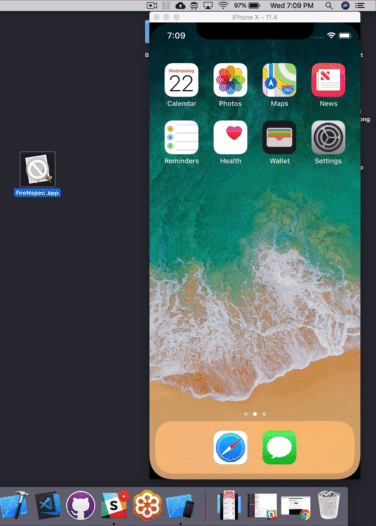- Aug 17, 2021 Specifying a device#. You can specify the device the simulator should run with the -simulator flag, followed by the device name as a string. The default is 'iPhone 11'. If you wish to run your app on an iPhone SE (1st generation), run npx react-native run-ios -simulator='iPhone SE (1st generation)'. The device names correspond to the list of.
- Sometimes the iOS simulator doesn't respond to commands to open. If it seems to be stuck on this prompt, you can open the iOS simulator manually (open -a Simulator) and then in the macOS toolbar choose Hardware → Device and select an iOS version and device that you'd like to open.
- Sep 19, 2021 Chief among these is the ability to natively run iOS and iPadOS apps on a macOS system. IPhone and iPad Apps Are Coming to the Mac Apple is already producing its own processors for the iPhone, iPad, and most of its non-Mac lineup (including the Apple TV, HomePod, and Apple Watch). Xamarin TestFlight is an iOS emulator that lets you run iOS apps.
Well, if you’re looking for an iOS emulator for testing your new app, or just to run some iOS apps on your computers, we’ve got you covered. Here are 5 iOS emulators for Windows 10 and macOS you can try.
Have you ever wondered how to launch a specific iOS simulator directly using the ionic cli instead of launching XCode and choosing the simulator from the list? I have... many times... But I was always too lazy to look for the answer. As it turns out, it's pretty simple. And it's quite helpful when you want to debug your iOS app using Ionic's live reload feature!
So, as I said, when you run ionic on iOS with live reload, you run this:

But at the end of all these complicated build lines you can read:
'Oh! So I could specify a target!' And then the simulator launches and the idea of specifying a target just vanishes until the next launch.
Well, no more laziness, sir! Let's specify this bloody target!
There seems to be more than one command line available to do this, but hey, we only need one that's working. Just run:
Macos Run Ios Simulator Download
You should see a list of all the simulators available like this:

OK, so now we have our available simulators. We just need to specify it to Cordova! And that's done like that:
Ios Simulator Download
And that's it folks! The iPhone 6 simulator will launch instead of the default one. That was easy, right?

If you have questions or remarks concerning this article, please feel free to share them in the comments below!
Darling is a translation layer that lets you run macOS software on Linux
Fast
Darling runs macOS software directly without using a hardware emulator.
Free
Like Linux, Darling is free and open-source software.
It is developed openly on GitHub and distributed under the GNU GPL license version 3.Compatible
Darling implements a complete Darwin environment. Mach, dyld, launchd — everything you'd expect.
Easy to use
Darling does most of the setup for you. Sit back and enjoy using your favorite software.
Native
We aim to fully integrate apps running under Darling into the Linux desktop experience by making them look, feel and behave just like native Linux apps.

That sounds a lot like Wine
And it is! Wine lets you run Windows software on Linux, and Darling does the same for macOS software. Another similar project is Anbox, for Android apps.
Does it support GUI apps?
Almost! This took us a lot of time and effort, but we finally have basic experimental support for running simple graphical applications.
Does it violate Apple's EULA?
No! We only directly use those parts of Darwin that are released as fully free software.
Does the name Darling mean anything?
The name Darling is a combination of “Darwin” and “Linux”. Darwin is the core operating system macOS and iOS are based on.
Can I run Darling on Windows using WSL?
With WSL 2, yes! See the documentation for more details.
Do you know about opensource.apple.com, GNUstep, The Cocotron and other projects?
We do, and in fact, Darling is largely based on the original Darwin source code published by Apple. We use The Cocotron as a basis for our Cocoa implementation, along with the Apportable Foundation and various bits of GNUstep.
Do you have plans for supporting iOS apps?
Yes, in the long run, we'd like to be able to run iOS apps on ARM devices (like most Android phones). A significant challenge here would be to write our own implementation of UIKit. Come talk to us if you're interested in working on this!
How do I contribute?
Start by reading the documentation and our blog to get familiar with Darling internals. Then, come and join us on GitHub. It's great if you have experience in developing for macOS or iOS, but it's absolutely not required to start contributing.